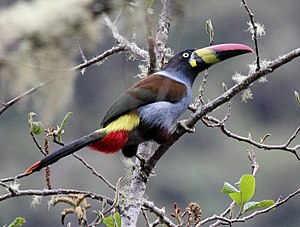Blue toucan
| Blue toucan | ||||||||||
|---|---|---|---|---|---|---|---|---|---|---|

Blue toucan ( Andigena hypoglauca ) |
||||||||||
| Systematics | ||||||||||
|
||||||||||
| Scientific name | ||||||||||
| Andigena hypoglauca | ||||||||||
| ( Gould , 1833) |
The Gray-breasted mountain toucan ( Andigena hypoglauca ) is a species from the genus of the mountain toucan ( Andigena ) in the family of toucans (Ramphastidae), which in South America occurs.
Blue toucans only inhabit mountain forests and, due to their size and large, multi-colored beak, can only be confused with a few other species of toucan. The otherwise similar black- billed toucan has a striking white throat in contrast to the blue toucan. The black-headed toucan does not have a partially orange-red beak. Two subspecies of the blue toucan are described.
The IUCN classifies the blue toucan as slightly threatened ( near threatened ). Exact population figures are not available, but suitable habitats are increasingly being destroyed in the distribution area, so that population figures are declining.
Appearance
The body length of adult blue toucans is 43 to 48 centimeters. The males of the nominate form reach a wing length of 16.3 to 18.2 centimeters. The tail is between 15.9 and 17.5 inches long. The beak length is 8.9 to 9.6 centimeters. There is no noticeable sexual dimorphism , but females tend to be slightly smaller and have a slightly shorter beak at 6.9 to 8.3 centimeters.
The males have a black skull and black sides of the face. A gray-blue band runs across the neck, which becomes a little darker on the sides of the neck and tapers off. The upper back is brown, the trunk is green-brown, while the end of the trunk is bright yellow. The upper tail-coverts are gray-green. The tail is black-brown. The chin is soot-colored, while the throat is gray-blue. The abdomen is pale gray-blue, the sides of the abdomen are a little darker. The thighs are dark maroon, the coverts under the tail are bright red.
The upper beak is yellow at the base with a black spot, otherwise it is orange-red. The lower bill is also yellow at the base and, like the upper beak, has a black spot. The lower beak is black at the top. The featherless skin of the face is blue and black directly around the eye. The eyes are brown, the feet and legs are greenish-yellow to brown-green.
The subspecies Andigena h. lateralis differs from the nominate form by light yellow breast spots, a chocolate brown thigh color and an olive yellow iris color.
Distribution area
The blue toucan occurs only in high Andean forests from central Colombia and Venezuela to Ecuador and Peru . It lives in higher altitudes than other Andigena species as well as the Derby , gray-billed , yellow-browed and leek arassari , all of which belong to the genus of the green arassaris and are also toucans of the mountain region. In Venezuela the blue toucan is observed between 1800 and 2700 meters above sea level, in Ecuador it occurs at altitudes between 2200 and 3650 meters. It is generally considered a rare species.
Its habitat are humid mountain forests of the temperate zone, cloud forests and wooded river banks. It is also found in dense secondary forests and on the edges of forests.
Way of life
The blue toucan is mostly found in tree tops. Only occasionally does it come near the ground to eat berries. During the foraging for food he is not very happy to call. It is mainly observed individually, in pairs or in small groups of up to six individuals. The latter are probably family associations. While foraging for food, blue toucans are occasionally associated with mountain kassiks ( Cacicus leucoramphus ), blue-backed mountain tangs ( Buthraupis montana ) and giant thrushes ( Turdus fuscater ). Their posture while foraging is typically very upright. The diet consists mainly of fruits; Animal nutrition probably plays a role during the rearing of nestlings. No research results are available on the reproductive behavior. The breeding season in Colombia probably falls between January and February. In Peru, young birds that had just flown out were observed in November.
swell
literature
- Werner Lantermann: Toucans and Arassaris. Filander Verlag, Fürth 2002, ISBN 3-930831-46-5
- Lester L. Short and Jennifer FM Horne: Toucans, Barbets and Honeyguides - Ramphastidae, Capitonidae and Indicatoridae . Oxford University Press, Oxford 2001, ISBN 0-19-854666-1
Individual evidence
- ↑ BirdLife factsheet on the blue toucan , accessed January 1, 2011
- ^ Lantermann, p. 162
- ↑ Short et al., P. 3587
- ↑ Short et al., P. 359
- ↑ Short et al., P. 359
- ↑ Lantermann, p. 164
Web links
- Andigena hypoglauca inthe IUCN Red List of Threatened Species 2013.1. Listed by: BirdLife International, 2012. Retrieved October 23, 2013.

